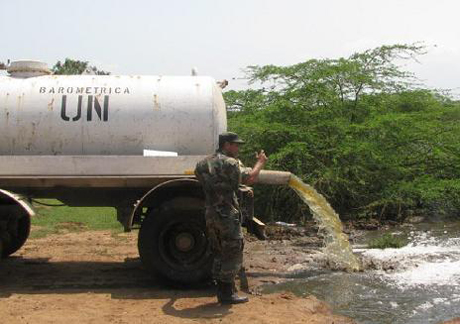
A makeshift latrine hangs over the water at the edge of Cite de Dieu, a slum in Port-au-Prince, Haiti.
John W. Poole / NPR/John W. Poole / NPR
It’s been more than three years since cholera struck Haiti. And the epidemic continues today.
The deadly bacteria have killed more than 8,500 people. And it has infected hundreds of thousands.
Why has the outbreak been so hard to contain — especially given the in foreign aid pledged to the country?
Lack of sanitation, says journalist Jonathan Katz, who has been covering the cholera epidemic since it began.
Haiti doesn’t have sewers. Instead, the country relies on what’s known as the : independent, and somewhat secretive, laborers who clean the cesspools under people’s latrines.
LISTEN TO THE RADIO DISCUSSION HERE 4mins
“Almost all of them are men … and they work in a very interesting way,” he says. “The job is done is by hand. They climb into the latrines with a bucket. They scoop out the excrement and put it somewhere else.”
“The job is incredibly important,” Katz says, “because it’s basically the only way that people who have underground cesspools, dug under latrines in their backyard, to get them clean.”
But even having a latrine is a luxury and not common in Haiti.
“Most people in Haiti can’t afford even that kind of cesspool,” Katz says. “So what most people do, especially in the rural areas, is that they look for an open field or they look for a canal. Most people prefer to go at dawn.”
And when those choices aren’t available, many people use an even less sanitary method: the so-called flying toilet.
“You take a plastic bag. You go in the plastic bag. And then you throw it,” Katz says. “That’s the way the sanitation tends to get done.”
After the 2010 earthquake, foreign aid flooded into Haiti. And a major concern then was getting clean water and toilets into the country. But nothing has been done to solve Haiti’s water and sanitation problems permanently, Katz says.
“There were very, very short-term, band aid type solutions,” he says. “For instance, the bladders of water provided to the displacement camps and the porta potties being installed in big, visible places. They weren’t long-term, durable solutions,” Katz says.

Evidence suggests the cholera in Haiti came from a United Nation’s base, where Nepalese peacekeeping troops lived. The strain of cholera in Haiti exactly matches that one found at the UN base. And the sanitation on the base wasn’t sufficient enough to prevent contamination of the adjacent river.
Haitian citizens recently a lawsuit against the UN. They’re seeking compensation for the spread of cholera.
“Before these lawsuits were brought forward, UN officials were trying to actively deny they were responsible,” Katz says. “Since then, the science [supporting the claim] has been so overwhelming that the UN basically doesn’t even take up the issue of whether it’s responsible.”
And once cholera takes hold in region, the infectious disease doesn’t leave easily.
“It’s very hard to get out of the environment,” Katz says. “But that said, there have been many places in the world that have dealt with horrific cholera epidemics over very long periods of time.”
What was the solution? Sewers and better sanitation. “Build underground pipes,” Katz says. “As long as people continue to drink water that is infected, cholera is going to be a major problem.”
____________________________________________________________
COMMENT: HAITIAN TRUTH.ORG
Why is the calculator stuck at 8500??
This figure was passed in the first 12 months.
Cholera has probably taken more than 30,000 lives since the Nepalese detachment was caught – by Al Jazeera – dumping their shit directly into the Artibonite River system, It wasn’t a leaky septic tank – it was a tanker truck backed up to the river!!!

What most needs to be done is to relieve all occupying UN troops. Get them out of the country… They weren’t necessary in the first place… They’ve done no good but harm… They’re costing the people too much money, resources, and land…